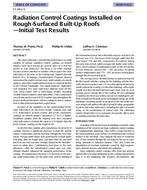
SF-98-02-3 — Radiation Control Coatings Installed on Rough-Surfaced Built-Up Roofs-Initial Test Results
The solar reflectance and thermal performance of small samples of various radiation control coatings on smooth surfaces have been tracked for several years on a roof test facility in East Tennessee. The focus is on white coatings because of their potential to weather, which causes the solar reflectance to decrease as the coatings age. Support from the federal New Technology Demonstration Program allowed extension of the study to include more small samples on smooth surfaces and entire rough-surfaced roofs at a federal facility in the Florida Panhandle. Two rough-surfaced, moderately well insulated, low solar reflectance built-up roofs (BURs) were spray-coated with a latex-based product including ceramic beads to improve solar reflectance. Only a small patch was left uncoated on each BUR to gather data throughout the project on the performance with no coating for direct comparison to data from instrumented coated areas.
Because of the roughness of the gravel-topped BURs, solar reflectances for the fresh ceramic coatings were only 0.53. Reflectances of fresh ceramic and acrylic elastomeric coatings on smooth surfaces measured 0.23 to 0.32 higher. Weathered samples from the ongoing tests have measured solar reflectances of about the same to 0.10 higher than the fresh ceramic coatings on the rough BURs.
In the first three months after installation, the fresh BUR coatings showed a significant decrease in both the outside surface temperature and the heat flux through the roof insulation. Average sunlit values were generated to exclude nighttime data, data on cloudy days, and data when the uncoated patch on one roof was more strongly shaded in the mid-afternoon on sunny days. Contributions from times in the early afternoon, when the instrumented coated area was more strongly shaded, enhanced the apparent performance of the coating. The shaded area showed a 15% decrease in the average sunlit temperature; for the other roof, with no shading of the instrumented areas but a thermally massive roof deck, the decrease was 11%. Decreases in the average sunlit heat flux were larger: 55% and 36%, respectively. By contrast, during the same time period, sunlit averages for higher solar reflectance, fresh coatings on uninsulated roofs on the test facility in East Tennessee showed 26% – 28% decreases in outside surface temperatures and 77% – 78% decreases in heat fluxes through the plywood roof decks.
The average power demand during occupied periods for the first month with the coating for the building with the thermally massive roof deck was 13% less than during the previous month without the coating. For the other building, with a lightweight roof deck but high internal loads, there were no clear average power savings due to the coating. We are continuing to monitor electricity use in these all-electric buildings to calibrate a model for the peak power and annual energy use of the buildings. Modeling results to be given at the end of the two-year project will address the effect of roof R-value, geographic location, and solar reflectance, including the effect of weathering, on the performance of coated roofs. The calibrated models should allow us to segregate site-specific effects such as shading and large thermal mass.
Units: Dual
Citation: Symposium, ASHRAE Transactions, 1998, Vol 104, pt. 1A, San Francisco
Product Details
- Published:
- 1998
- Number of Pages:
- 15
- File Size:
- 1 file , 320 KB
- Product Code(s):
- D-7841


